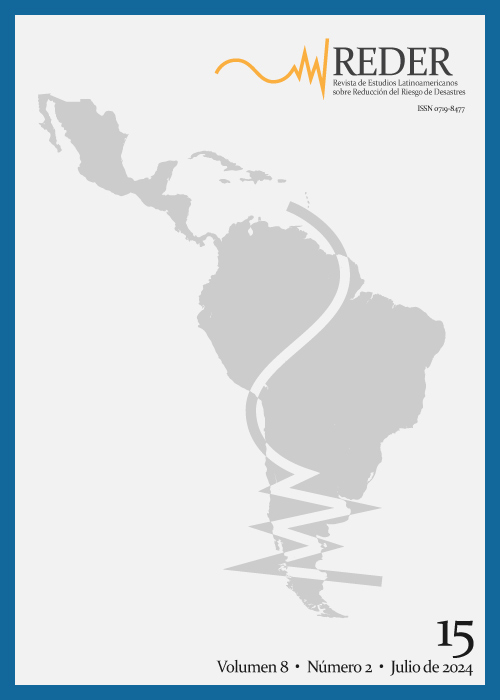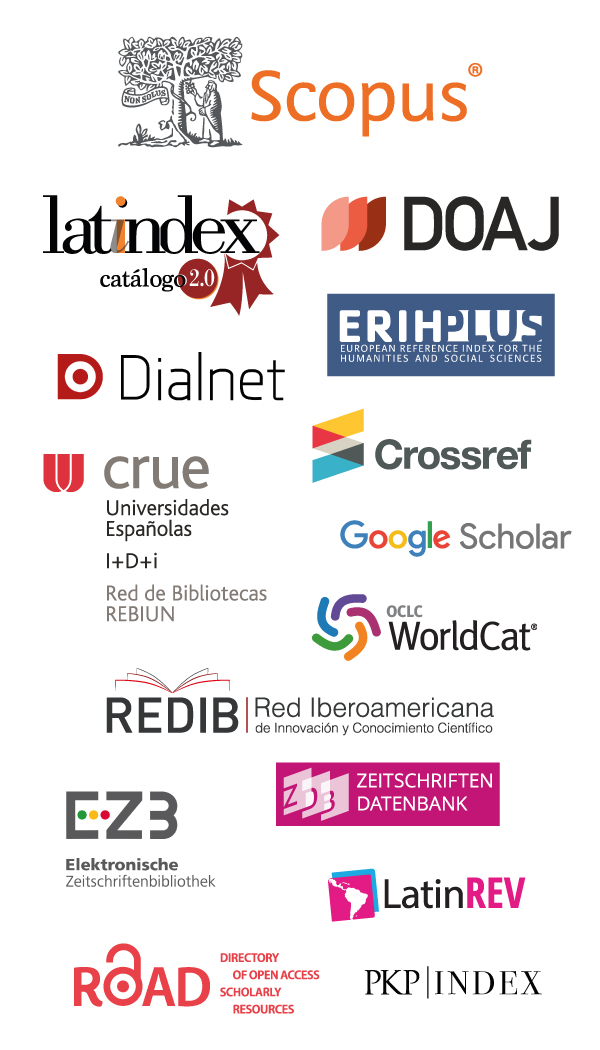Certificado de Posgrado en Planificación del Desarrollo Local, Ordenamiento Territorial y Gestión del Riesgo: Estudio Longitudinal KAP
DOI: https://doi.org/10.55467/reder.v6i2.100
Resumen
Este estudio evalúa la retención de conocimientos de los egresados de la quinta cohorte del Certificado en 'Planificación del desarrollo local, ordenamiento territorial y gestión del riesgo de desastres' (PDLOTGR), postgrado implementado en Latinoamérica durante el 2020 y 2021. Este es el segundo estudio sobre rendimiento académico del Certificado. El primero se centró en la evaluación de las cuatro primeras cohortes 2016-2020. Este estudio longitudinal se basa en una evaluación previa y una posterior a la capacitación. El diseño incluye una adaptación del método de Conocimiento, Actitud y Práctica (KAP), una encuesta, la aplicación del índice KAP, y el empleo de la prueba Wilcoxon para evaluar la diferencia entre las dos evaluaciones. Los resultados confirman que el mayor valor obtenido en el KAP posterior a la capacitación para los subíndices de conocimiento y práctica, así como para el índice compuesto KAP es estadísticamente significativo. Estos resultados indican un impacto positivo y duradero (6-14 meses) del PLDOTGR que coloca a sus egresados en una mejor posición para desempeñarse en temas complejos vinculados a la seguridad del territorio. El estudio reafirma la utilidad del método KAP para evaluar el nivel percibido de conocimiento, actitud y práctica de un grupo de profesionales capacitados.
Palabras clave
Texto completo:
PDFReferencias
Aguilar, A. (1989), “Las bases del ordenamiento territorial. Algunas evidencias de la experiencia cubana”, Revista Geográfica, No. 109, pp. 87-111.
Bathrellos, G.D. and Skilodimou, H.D. (2019), “Land use planning for natural hazards”, Land, Vol. 8 No. 9, p. 128. http://doi.org/10.3390/land8090128
Benedek, J., Varvari, S. & Litan, C.M. (2019), “Urban growth pole policy and regional development: old wine in new bottles?”, in Lang, T. and Görmar, F. (Eds), Regional and Local Development in Times of Polarisation, Springer Singapore, pp. 173-195.
Berkowitz, J.M., Huhman, M., Heitzler, C.D., Potter, L.D., Nolin, M.J. & Banspach, S.W. (2008), “Overview of formative, process, and outcome evaluation methods used in the VERB campaign”, American Journal of Preventive Medicine, Vol. 34 No. 6, pp. S222-S229. http://doi.org/10.1016/j.amepre.2008.03.008
Castells, M. (1999), The Informational City: Information Technology, Economic Restructuring, and the Urban-Regional Process, Reprinted ed., Blackwell.
Castro, C.P., Ortiz, J., Delgado, J., Jiménez, V., Quiroga, S., Sosa, E., Valenzuela, M.C. & Sarmiento, J.P. (2008), “Aproximación metodológica a una articulación entre gestión del riesgo, gestión ambiental y ordenamiento territorial”, Revista de Estudios Geográficos, Vol. 4 No. 4, pp. 1-19.
Ellickson, R.C. & Thorland, C.D. (1995), “Ancient land law: Mesopotamia, Egypt, Israel”, Chicago-Kent Law Review, Vol. 71 No. 1, pp. 321-411.
Gan, X., Fernandez, I.C., Guo, J., Wilson, M., Zhao, Y., Zhou, B. & Wu, J. (2017), “When to use what: methods for weighting and aggregating sustainability indicators”, Ecological Indicators, Vol. 81, pp. 491-502. https://doi.org/10.1016/j.ecolind.2017.05.068
Gardner, D.S. (1951), “Almost-forgotten law book”, Notre Dame Law Review, Vol. 27 No. 1, pp. 43-65.
Gaussier, N., Lacour, C. & Puissant, S. (2003), “Metropolitanization and territorial scales”, Cities, Vol. 20 No. 4, pp. 253-263. http://doi.org/10.1016/S0264-2751(03)00032-5
Glavovic, B. (2010), “The role of land-use planning in disaster risk reduction: an introduction to perspectives from Australasia”, Australasian Journal of Disaster and Trauma Studies, No. 1, pp. 1-22.
Gray de Cerdán, N., Quiroga, S. & Cad, M. (2008), “Articulation of land use management and risk management”, En Sarmiento, J.P. (Ed.), Time to Pass the Baton: Disaster Risk Reduction From the Perspective of Environmental Management, Land Use Management, Finance and Public Investment, Editorama, S.A., pp. 79-198.
Gumucio, S. (2011), “The KAP survey model (knowledge, attitude and practices)”, Medecins du Monde, USAID and SPRING [online]. https://www.medecinsdumonde.org/en/actualites/publications/2012/02/20/kap-survey-model-knowledge-attitude-and-practices
Gupta, A.K. & Nair, S.S. (2012), Environmental Legislation for Disaster Risk Management, National Institute of Disaster Management & Deutsche Gesellschaft fur Internationale Zusammenarbeit (GIZ).
Haldon, J., Roberts, N., Izdebski, A., Fleitmann, D., McCormick, M., Cassis, M., Doonan, O., Eastwood, W., Elton, H., Ladst€atter, S., Manning, S., Newhard, J., Nicoll, K., Telelis, I. & Xoplaki, E. (2014), “The climate and environment of byzantine anatolia: integrating science, history, and archaeology”, Journal of Interdisciplinary History, Vol. xlv No. 2, pp. 113-161.
Harris, P.A. (1988), “Actual knowledge, perceived knowledge and interest in selected health areas of Southwestern Louisiana University Freshmen, 1985”, LSU Historical Dissertations and Theses, 4504, Louisiana State University. https://digitalcommons.lsu.edu/gradschool_disstheses/4504
Hiernaux, D. & Lindón, A. (2000), “Una aproximación a la construcción social del lugar en la periferia de la Ciudad de México”, En La Construcción Social de Un Territorio Emergente: El Valle de Chalco, Dirección de Cultura, pp. 9-30.
James, S., Swan, K. & Daston, C. (2015), “Retention, progression and the taking of online courses”, Online Learning, Vol. 20 No. 2. http://doi.org/10.24059/olj.v20i2.780
King, D., Gurtner, Y., Firdaus, A., Harwood, S. & Cottrell, A. (2016), “Land use planning for disaster risk reduction and climate change adaptation: operationalizing policy and legislation at local levels”, International Journal of Disaster Resilience in the Built Environment, Vol. 7 No. 2, pp. 158-172. http://doi.org/10.1108/IJDRBE-03-2015-0009
Launiala, A. (1970), “How much can a KAP survey tell us about people’s knowledge, attitudes and practices? Some observations from medical anthropology research on malaria in pregnancy in Malawi”, Anthropology Matters, Vol. 11 No. 1, pp. 1-13. http://doi.org/10.22582/am.v11i1.31
Lobsy, J. & Wetmore, A. (2012, 14 de febrero), “Using Likert scales in evaluation survey work”, Presented at the CDC’s Coffee Break, Atlanta [online]. https://www.cdc.gov/dhdsp/pubs/docs/cb_february_14_2012.pdf
Massiris, A. (2002), “Ordenación del Territorio en América Latina”, Revista Electrónica de Geografía y Ciencias Sociales, Vol. 1 No. 125, pp. 741-798. http://doi.org/10.1016/j.ijdrr.2016.10.006
Méndez, E. (1990), Gestión Ambiental y Ordenación Del Territorio, Universidad de los Andes, Facultad de Ciencias Forestales, Instituto de Geografía y Conservación de Recursos Naturales.
Oliver-Smith, A., Alcántara-Ayala, I., Burton, I. & Lavell, A. (2017), “The social construction of disaster risk: seeking root causes”, International Journal of Disaster Risk Reduction, Vol. 22, pp. 469-474.
Ritchie, K.C., Snelgrove-Clarke, E. & Murphy, A.L. (2019), “The 23-item Evidence Based Practice-Knowledge Attitudes and Practices (23-item EBP-KAP) survey: initial validation among health professional students”, Health Professions Education, Vol. 5 No. 2, pp. 152-162. http://doi.org/10.1016/j.hpe.2018.09.004
Rumbach, A. (2019), “Mitigating natural hazards through land-use planning”, Department of Urban Planning, Texas A&M University [online]. http://www.andrewrumbach.com/blog/2019/4/14/mitigating-natural-hazards-through-land-use-planning
Sarmiento, J.P., Sarmiento, C., Hoberman, G. & Chabba, M. (2021), “Graduate certificate in local development planning, land use management and disaster risk management: a knowledge, attitude and practice (KAP) evaluation”, Disaster Prevention and Management: An International Journal, Vol. 30 No. 4/5, pp. 510–524.
Saunders, W.S.A. & Kilvington, M. (2016), “Innovative land use planning for natural hazard risk reduction: a consequence-driven approach from New Zealand”, International Journal of Disaster Risk Reduction, Vol. 18, pp. 244-255. http://doi.org/10.1016/j.ijdrr.2016.07.002
Shaw, M., Scott, B. & Ferguson, K. (2016), “Factors that influence student attrition in online courses”, Online Journal of Distance Learning Administration, Vol. 19 No. 3. https://ojdla.com/archive/fall193/shaw_burrus_ferguson193.pdf
Warf, B. & Storper, M. (2000), “The regional world: territorial development in a global economy”, Economic Geography, Vol. 76 No. 1, p. 101.
Watrin, L., Geiger, M., Spengler, M. & Wilhelm, O. (2019), “Forced-choice versus Likert responses on an occupational big five questionnaire”, Journal of Individual Differences, Vol. 40 No. 3, pp. 134-148. http://doi.org/10.1027/1614-0001/a000285
Wilson, A. (2012), “Water, power and culture in the Roman and Byzantine worlds: an introduction”, Water History, No. 4, pp. 1-9. http://doi.org/10.1007/s12685-012-0050-2
Youssef, A. (1999), Cultura, espacio y organización urbana en la ciudad islámica, Instituto Juan de Herrera.
Enlaces refback
- No hay ningún enlace refback.








